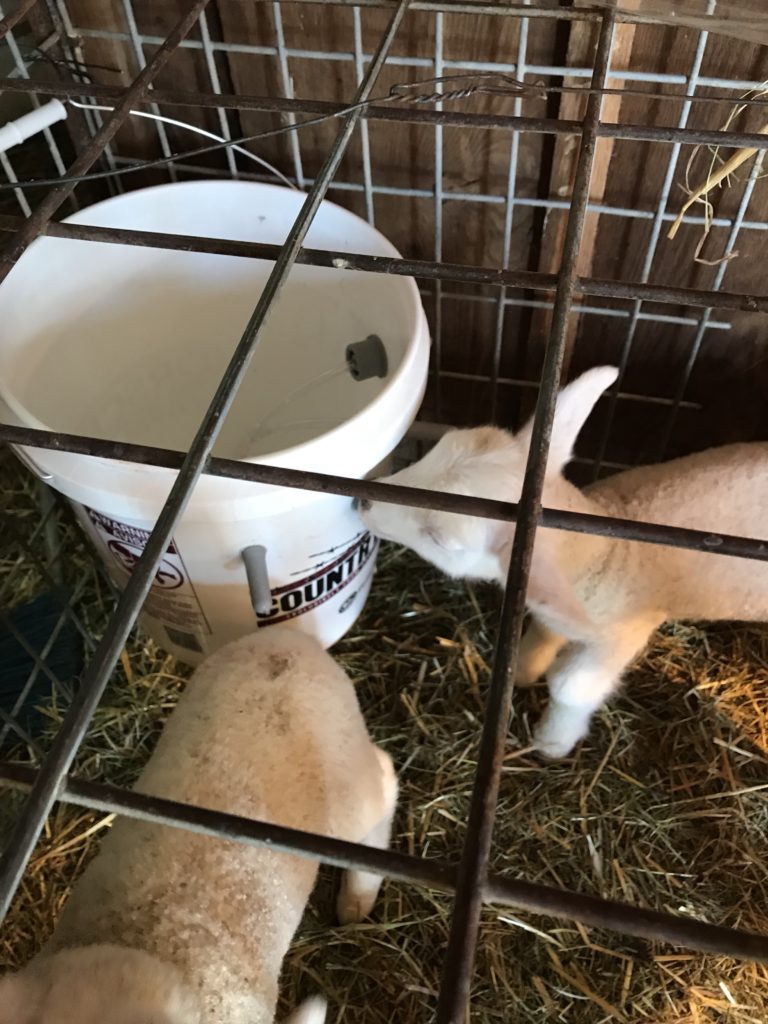If you’re like me, time is precious. Although I enjoy working with bottle babies, whether it’s lambs, kids, or calves, I also have many other projects demanding my time. So this year when we ended up with six bottle lambs, I needed to find an efficient way to feed them. At first, we were using plastic drink bottles. We don’t drink much pop so the kids were pleased to have to drink some so we could have the leftover bottles to use. (The plastic that water bottles are made of is way to soft! The lambs would collapse the water bottles on the first or second use.) Even the pop bottles don’t hold up very long before the lambs collapse them as well. We needed a better solution that would also save us time; but we didn’t have a big budget to buy a specialized feeder. I decided we would just build our own.

Supplies List
Bucket at the local farm store costs $3.29 and the optional lid costs $1.79. Other ideas for buckets would be to reuse a square bucket that cat litter comes in. The flat sides would also fit up against the fence better.
10 Replacement nipples $17.95 plus shipping $10.95 for a total of $28.90 (from Hoegger Supply Co.)
Plastic tubing for straws $.49/ ft and we used 1 foot per nipple.
Putting the Bucket Together
I used a 9/16″ drill bit to drill the desired number of holes about 5-6″ from the top of the bucket. I then just pulled the nipples from the inside of the bucket to the outside. The nipples have a groove that will fit right in the drilled hole. I cut that plastic tubing just so that it reaches the bottom of the bucket. If the tubing is too long, it will curl back up and the babies won’t be able to drink all the milk. If the tubing is too short, you’ll have the same problem of them not being able to drink all the milk.
We set up two buckets; one for four lambs and one for two lambs. We needed the lambs to be on seperate buckets because there was considerable size difference, since the first two lambs are a month older than the other four.
The two lamb bucket cost $10.05. The four lamb bucket cost $16.81 and we still have four replacement nipples on hand to use later. So for $26.86 we have two feeders that will last for quite a long time. If the nipples get worn or torn, we simply take the old ones out and replace with a new on.
On the other hand, to purchase a ready-made 10 Kid/Lamb feeder would have cost $49.99 with an additional $10.95 in shipping. That would give us a total of $60.94 for just the one bucket. For less than half this cost we have two buckets!
This has also been a huge time saver for us. We have several does we are milking currently, so we simply milk the neccessary milk for the lambs into an ice cream bucket and walk over and dump it into the lamb bucket. It really can’t get any easier than that. When we were feeding the lambs four times per day, we would simply bring the next feeding of milk to the house. The lambs never seemed to mind drinking it at room temperature when it wasn’t milking time.
As the lambs get older and more aggressive, it is important to take the bucket out of the pen between feedings. Otherwise, they tear up the nipples by chewing and pulling on them. After a couple weeks, the lambs would slurp up all the milk in a VERY short amount of time. The other issue we had with leaving the bucket in the pen full time was the lambs would be rough enough on the nipples to make the straws fall out. Then you have to stick straws back in before dumping the next milk in. It’s much easier to take the bucket out between feedings.
Blessings,
Jennifer

I am wondering how you clean this feeding contraption, and how often? I am about to head into my second bottle baby season and need to make some changes to how I do things (ie. no individual bottles!!!)
I gave it a quick rinse once a day with a thorough cleaning when it seemed to need it.
How do you regulate how much each lamb consumes? I’m concerned the most voracious of the lambs would eat their share and more.
I try to match up the age/size of the lambs so that older lambs don’t take all the milk before the younger ones get a chance. This has worked for us.